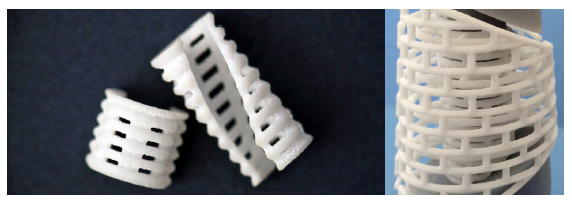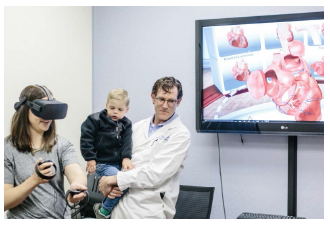J&J Company Buys 3D Printing Technology to Create Bone-healing Implants
Trend Watch: Pharma, academia, and health techs employ innovation to improve patient care.
 DePuy Synthes Products, part of the Johnson & Johnson Family of Companies, has acquired 3D printing technology from Tissue Regeneration Systems (TRS) to create patient-specific, bioresorbable implants with a unique mineral coating intended to support bone healing in patients with orthopedic and craniomaxillofacial deformities and injuries. With more than 50 strategic collaborations, the Johnson & Johnson Family of Companies is harnessing 3D printing technology to develop patient-specific healthcare solutions that can mean increased satisfaction and better clinical outcomes. The acquisition from TRS brings new technology with the potential to truly personalize healthcare solutions in the trauma space, a priority platform for the business.
DePuy Synthes Products, part of the Johnson & Johnson Family of Companies, has acquired 3D printing technology from Tissue Regeneration Systems (TRS) to create patient-specific, bioresorbable implants with a unique mineral coating intended to support bone healing in patients with orthopedic and craniomaxillofacial deformities and injuries. With more than 50 strategic collaborations, the Johnson & Johnson Family of Companies is harnessing 3D printing technology to develop patient-specific healthcare solutions that can mean increased satisfaction and better clinical outcomes. The acquisition from TRS brings new technology with the potential to truly personalize healthcare solutions in the trauma space, a priority platform for the business.
TRS’ implants use scaffold technology designed to create devices that are porous enough to be integrated into the bone, while remaining strong enough to bear loads while the body is healing. As healing happens, the device is fully replaced by bone.
TRS thinks its implants can eliminate the need to harvest bone grafts and cut the need for midoperation modification by providing surgeons with tailor-made devices.
Verily Kicks Off Baseline Study To Help Predict Illness
Verily, the life-sciences company owned by Google’s parent company, Alphabet, has launched Baseline, its long-awaited study of 10,000 healthy people. Project Baseline is a broad effort designed to develop a well-defined reference, or “baseline," of good health as well as a rich data platform that may be used to better understand the transition from health to disease and identify additional risk factors for disease.
Google first announced its plans to carry out the Baseline study back in 2014. The idea is that by tracking the health of healthy people, researchers might be able to pick up on ways to predict when a person will get a disease. Researchers hope to figure out how to identify people who have a change in their health early enough where an intervention would be helpful in keeping that person healthy. The study will run for at least four years.
At the end of the four years, Verily is hoping to get new insights into how cancer and heart disease develops before it’s diagnosed, while also figuring out how to come up with health technology that will be useful. The company will compensate those who take part in the trial, in addition to opening up its results to qualified researchers for cross-referencing.
Amazon and Merck Seek To USE lexa for Chronic Disease Management
Amazon and Merck have initiated an Alexa Diabetes Challenge to explore how voice-command technology can support chronic disease management. The two companies are asking developers to create Amazon Alexa voice-enabled solutions that help newly diagnosed Type 2 diabetes patients self-manage their care. The grand prize winner will receive $125,000. Up to five finalists will receive $25,000.
The challenge is looking for product concepts that use Amazon’s virtual assistant to help people, particularly those who have been recently diagnosed, manage the disease. The finalists will also be mentored in a virtual accelerator and attend an Innovator’s Boot Camp at Amazon’s headquarters in Seattle. All that will prepare the teams for Demo Day in September, held at the AWSPop-up loft in New York City. There, the finalists will demo their solutions for judges and one winner will be awarded the $125,000 grand prize.
Stanford Virtual Heart Revolutionizes Education on Congenital Heart Defects
 Pediatric cardiologists at Lucile Packard Children’s Hospital Stanford are using immersive virtual reality (VR) technology to explain complex congenital heart defects, which are some of the most difficult medical conditions to teach and understand. The Stanford Virtual Heart experience helps families understand their child’s heart conditions by employing a new kind of interactive visualization that goes far beyond diagrams, plastic models and hand-drawn sketches. For medical trainees, it provides an immersive and engaging new way to learn about the two dozen most common and complex congenital heart anomalies by allowing them to inspect and manipulate the affected heart, walk around inside it to see how the blood is flowing, and watch how a particular defect interferes with the heart’s normal function.
Pediatric cardiologists at Lucile Packard Children’s Hospital Stanford are using immersive virtual reality (VR) technology to explain complex congenital heart defects, which are some of the most difficult medical conditions to teach and understand. The Stanford Virtual Heart experience helps families understand their child’s heart conditions by employing a new kind of interactive visualization that goes far beyond diagrams, plastic models and hand-drawn sketches. For medical trainees, it provides an immersive and engaging new way to learn about the two dozen most common and complex congenital heart anomalies by allowing them to inspect and manipulate the affected heart, walk around inside it to see how the blood is flowing, and watch how a particular defect interferes with the heart’s normal function.
“The heart is a complicated three-dimensional organ, and it’s really hard to describe what’s going on inside of it — especially when something is going wrong," says David Axelrod, MD, clinical assistant professor of pediatric cardiology at Stanford University School of Medicine. Students at Stanford University School of Medicine are already using The Stanford Virtual Heart to learn about congenital heart defects and to help them visualize the procedures our pediatric heart surgeons use to correct these conditions.(PV)



















